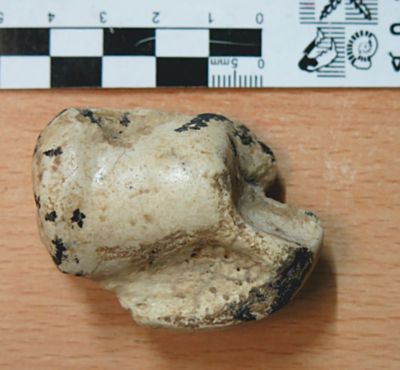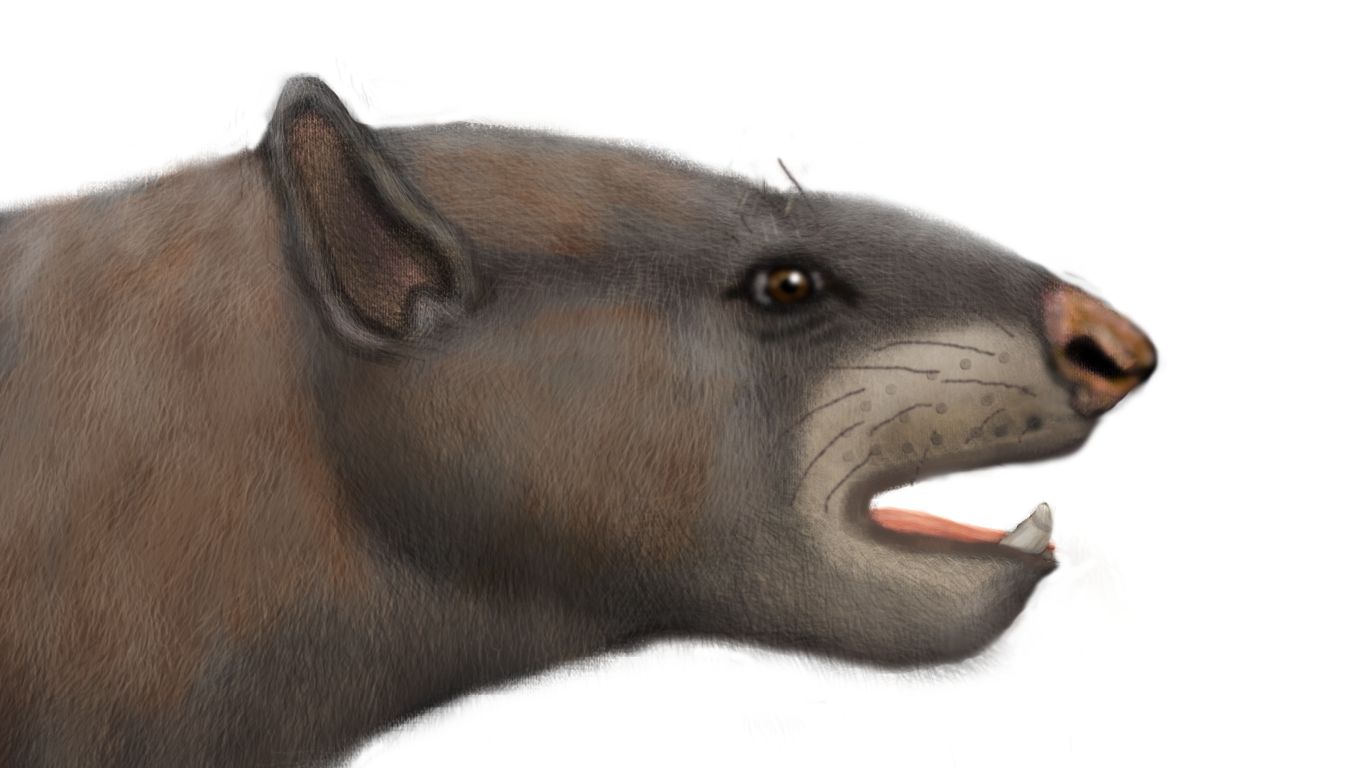|
Astraponotus
''Astraponotus'' is an extinct genus of astrapotheriids. It lived during the Middle-Late Eocene (in the Mustersan and Tinguirirican of the South American land mammal ages (SALMA), 48-33.9 million years ago) and its fossil remains have been found in the Sarmiento Formation of Argentina, South America.''Astraponotus'' at .org Description Unlike most astrapotheres, ''Astraponotus'' was equipped with an unusually high, short, narrow skull. The nasal bones were quite withdrawn, which suggests the presence of a short proboscis. Other unusual features of ''Astraponotus'' includes the extreme reduction of the |
Astrapotheria
Astrapotheria is an extinct order of South American and Antarctic hoofed mammals that existed from the late Paleocene to the Middle Miocene, ."The uruguaytheriine Astrapotheriidae from the rich middle Miocene Honda Group of the upper Magdalena River valley in Colombia (...) are the youngest securely dated remains of that order in South America." Astrapotheres were large and rhinoceros-like animals and have been called one of the most bizarre orders of mammals with an enigmatic evolutionary history. This taxonomy of this order is not clear, but it may belong to Meridiungulata (along with Notoungulata, Litopterna, Pyrotheria and Xenungulata). In turn, Meridungulata is believed to belong to the extant superorder Laurasiatheria. Some scientists have regarded the astrapotheres (and sometimes the Meridiungulata as a whole) as members of the clade Atlantogenata. However, collagen and mitochondrial DNA sequence data analysed in 2015 places at least the notoungulates and litopterns fir ... [...More Info...] [...Related Items...] OR: [Wikipedia] [Google] [Baidu] |
Astrapotheriidae
Astrapotheriidae is an extinct family of herbivorous South American land mammals that lived from the Late Eocene (Mustersan SALMA) to the Middle Miocene (Laventan SALMA) . The most derived of the astrapotherians, they were also the largest and most specialized mammals in the Tertiary of South America. There are two sister taxa: Eoastrapostylopidae and Trigonostylopidae. Around 1900, Argentine paleontologist Florentino Ameghino described eight Colhuehuapian (Early Miocene) species from specimens he found south of Lake Colhué Huapi in Patagonia and grouped them into three genera: '' Parastrapotherium'', ''Astrapotherium'', and '' Astrapothericulus''. It was obvious to Ameghino that these species represented a great diversity, ranging in size from a peccary to a rhinoceros, but his description was based entirely on fragmentary and not always comparable dental remains. Other expeditions to Patagonia have subsequently recovered considerably more complete materials. Genera According ... [...More Info...] [...Related Items...] OR: [Wikipedia] [Google] [Baidu] |
Sarmiento Formation
The Sarmiento Formation (Spanish: ''Formación Sarmiento''), in older literature described as the Casamayor Formation, is a geological formation in Chubut Province, Argentina, in central Patagonia, which spans around 30 million years from the mid-Eocene to the early Miocene. It predominantly consists of pyroclastic deposits, which were deposited in a semi-arid environment. It is divided up into a number of members. The diverse fauna of the Sarmiento Formation, including a variety of birds, crocodilians, turtles and snakes, also includes many mammals such as South American native ungulates (notoungulates, litopterns, astrapotheres) as well as armadillo Armadillos (meaning "little armored ones" in Spanish) are New World placental mammals in the order Cingulata. The Chlamyphoridae and Dasypodidae are the only surviving families in the order, which is part of the superorder Xenarthra, along wi ...s, and caviomorph rodents. Material was copied from this source, which is availabl ... [...More Info...] [...Related Items...] OR: [Wikipedia] [Google] [Baidu] |
Astrapotherium
''Astrapotherium'' ("lightning beast") is an extinct genus of South American mammals that vaguely resembled a small elephant or large tapir. However, it was unrelated to elephants or tapirs, but was instead related to other extinct South American ungulates. Fossils have been dated from the Early to Middle Miocene. Fossil remains of the type species ''A. magnus'' have been found in the Santa Cruz Formation in Argentina. Other fossils have been found in the Deseado, Sarmiento, and Aisol Formations of Argentina and Chile (Cura-Mallín Group).''Astrapotherium'' at .org Description [...More Info...] [...Related Items...] OR: [Wikipedia] [Google] [Baidu] |
Trigonostylops
''Trigonostylops'' is an extinct genus of South American meridiungulatan ungulate, from the Late Paleocene to Late Eocene (Itaboraian to Tinguirirican in the SALMA classification) of South America (Argentina and Peru) and Antarctica (Seymour Island). It is the only member of the family Trigonostylopidae. Description A complete skull of the type species, ''T. wortmani'', has been found, and it has been classified as an astrapothere based on its large lower incisors. Phylogeny Cladogram based in the phylogenetic analysis published by Vallejo Pareja ''et al''., 2015, showing the position of ''Trigonostylops'':Vallejo Pareja et al., 2015 Distribution Fossils of ''Trigonostylops'' have been found in:''Trigonostylops'' at |
Phylogenetic
In biology, phylogenetics (; from Greek φυλή/ φῦλον [] "tribe, clan, race", and wikt:γενετικός, γενετικός [] "origin, source, birth") is the study of the evolutionary history and relationships among or within groups of organisms. These relationships are determined by Computational phylogenetics, phylogenetic inference methods that focus on observed heritable traits, such as DNA sequences, protein amino acid sequences, or morphology. The result of such an analysis is a phylogenetic tree—a diagram containing a hypothesis of relationships that reflects the evolutionary history of a group of organisms. The tips of a phylogenetic tree can be living taxa or fossils, and represent the "end" or the present time in an evolutionary lineage. A phylogenetic diagram can be rooted or unrooted. A rooted tree diagram indicates the hypothetical common ancestor of the tree. An unrooted tree diagram (a network) makes no assumption about the ancestral line, and does ... [...More Info...] [...Related Items...] OR: [Wikipedia] [Google] [Baidu] |
Type Species
In zoological nomenclature, a type species (''species typica'') is the species name with which the name of a genus or subgenus is considered to be permanently taxonomically associated, i.e., the species that contains the biological type specimen(s). Article 67.1 A similar concept is used for suprageneric groups and called a type genus. In botanical nomenclature, these terms have no formal standing under the code of nomenclature, but are sometimes borrowed from zoological nomenclature. In botany, the type of a genus name is a specimen (or, rarely, an illustration) which is also the type of a species name. The species name that has that type can also be referred to as the type of the genus name. Names of genus and family ranks, the various subdivisions of those ranks, and some higher-rank names based on genus names, have such types. [...More Info...] [...Related Items...] OR: [Wikipedia] [Google] [Baidu] |
Patagonia
Patagonia () refers to a geographical region that encompasses the southern end of South America, governed by Argentina and Chile. The region comprises the southern section of the Andes Mountains with lakes, fjords, temperate rainforests, and glaciers in the west and deserts, tablelands and steppes to the east. Patagonia is bounded by the Pacific Ocean on the west, the Atlantic Ocean to the east, and many bodies of water that connect them, such as the Strait of Magellan, the Beagle Channel, and the Drake Passage to the south. The Colorado and Barrancas rivers, which run from the Andes to the Atlantic, are commonly considered the northern limit of Argentine Patagonia. The archipelago of Tierra del Fuego is sometimes included as part of Patagonia. Most geographers and historians locate the northern limit of Chilean Patagonia at Huincul Fault, in Araucanía Region.Manuel Enrique Schilling; Richard WalterCarlson; AndrésTassara; Rommulo Vieira Conceição; Gustavo Walter Bertotto; ... [...More Info...] [...Related Items...] OR: [Wikipedia] [Google] [Baidu] |
Spanish Language
Spanish ( or , Castilian) is a Romance languages, Romance language of the Indo-European language family that evolved from colloquial Latin spoken on the Iberian peninsula. Today, it is a world language, global language with more than 500 million native speakers, mainly in the Americas and Spain. Spanish is the official language of List of countries where Spanish is an official language, 20 countries. It is the world's list of languages by number of native speakers, second-most spoken native language after Mandarin Chinese; the world's list of languages by total number of speakers, fourth-most spoken language overall after English language, English, Mandarin Chinese, and Hindustani language, Hindustani (Hindi-Urdu); and the world's most widely spoken Romance languages, Romance language. The largest population of native speakers is in Mexico. Spanish is part of the Iberian Romance languages, Ibero-Romance group of languages, which evolved from several dialects of Vulgar Latin in I ... [...More Info...] [...Related Items...] OR: [Wikipedia] [Google] [Baidu] |
Miocene
The Miocene ( ) is the first geological epoch of the Neogene Period and extends from about (Ma). The Miocene was named by Scottish geologist Charles Lyell; the name comes from the Greek words (', "less") and (', "new") and means "less recent" because it has 18% fewer modern marine invertebrates than the Pliocene has. The Miocene is preceded by the Oligocene and is followed by the Pliocene. As Earth went from the Oligocene through the Miocene and into the Pliocene, the climate slowly cooled towards a series of ice ages. The Miocene boundaries are not marked by a single distinct global event but consist rather of regionally defined boundaries between the warmer Oligocene and the cooler Pliocene Epoch. During the Early Miocene, the Arabian Peninsula collided with Eurasia, severing the connection between the Mediterranean and Indian Ocean, and allowing a faunal interchange to occur between Eurasia and Africa, including the dispersal of proboscideans into Eurasia. During the ... [...More Info...] [...Related Items...] OR: [Wikipedia] [Google] [Baidu] |
Middle Eocene
The Eocene ( ) Epoch is a geological epoch that lasted from about 56 to 33.9 million years ago (mya). It is the second epoch of the Paleogene Period in the modern Cenozoic Era. The name ''Eocene'' comes from the Ancient Greek (''ēṓs'', "dawn") and (''kainós'', "new") and refers to the "dawn" of modern ('new') fauna that appeared during the epoch. The Eocene spans the time from the end of the Paleocene Epoch to the beginning of the Oligocene Epoch. The start of the Eocene is marked by a brief period in which the concentration of the carbon isotope 13C in the atmosphere was exceptionally low in comparison with the more common isotope 12C. The end is set at a major extinction event called the ''Grande Coupure'' (the "Great Break" in continuity) or the Eocene–Oligocene extinction event, which may be related to the impact of one or more large bolides in Siberia and in what is now Chesapeake Bay. As with other geologic periods, the strata that define the start and end of the ... [...More Info...] [...Related Items...] OR: [Wikipedia] [Google] [Baidu] |
Oligocene
The Oligocene ( ) is a geologic epoch of the Paleogene Period and extends from about 33.9 million to 23 million years before the present ( to ). As with other older geologic periods, the rock beds that define the epoch are well identified but the exact dates of the start and end of the epoch are slightly uncertain. The name Oligocene was coined in 1854 by the German paleontologist Heinrich Ernst Beyrich from his studies of marine beds in Belgium and Germany. The name comes from the Ancient Greek (''olígos'', "few") and (''kainós'', "new"), and refers to the sparsity of extant forms of molluscs. The Oligocene is preceded by the Eocene Epoch and is followed by the Miocene Epoch. The Oligocene is the third and final epoch of the Paleogene Period. The Oligocene is often considered an important time of transition, a link between the archaic world of the tropical Eocene and the more modern ecosystems of the Miocene. Major changes during the Oligocene included a global expansion o ... [...More Info...] [...Related Items...] OR: [Wikipedia] [Google] [Baidu] |





_(2).jpg)




